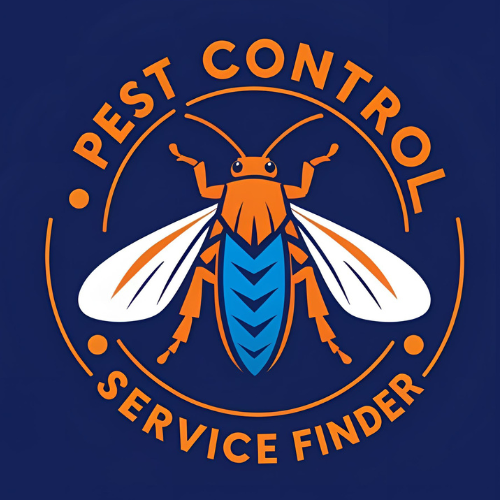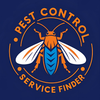Effective Tips to Keep Roaches Away from Your Home
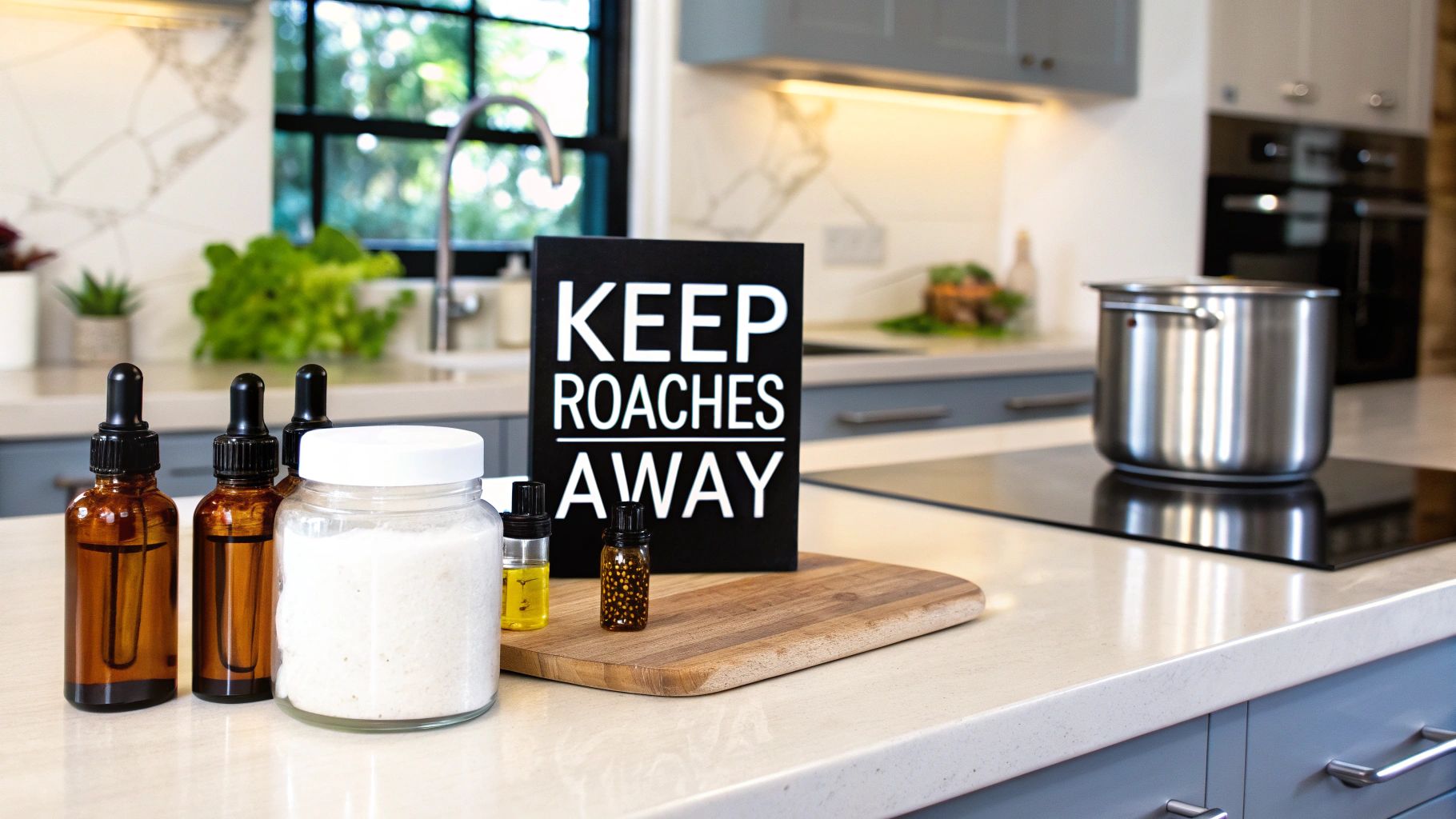
Dealing with a roach problem right now? Call +1 855 224 3071 for immediate, professional help.
The absolute best way to keep roaches away is to make your home an unwelcome place for them. This isn't about a one-time cleaning spree; it's about a consistent strategy that cuts off their access to food, water, and shelter. Think of it as building a fortress against pests, one small habit at a time.
Your Proactive Plan to Keep Roaches Out
Spotting a single cockroach is more than just startling—it's a sign. These pests are expert survivors, designed to exploit even the tiniest crumb or drop of water you might overlook. A truly roach-free home starts with understanding what they're looking for. Once you systematically take away their life support system, you build a powerful, long-term defense.
Of course, if you're facing a persistent issue that needs to be shut down now, your most effective first step is calling a professional at +1 855 224 3071.
A proactive plan means you stop reacting to sightings and start creating an environment that roaches will actively avoid. It's about building new habits around cleanliness, moisture, and how you store food.
The Foundation of Roach Prevention
The entire game plan for keeping roaches out boils down to one simple idea: make your home unattractive to them. This isn't about magic sprays; it's about integrating small, consistent actions into your daily routine. Your kitchen and bathrooms are the main battlegrounds because that's where you'll find the grease, crumbs, and standing water they love.
Here’s where to focus your energy:
- Sanitation: Get into the habit of wiping down counters, sweeping floors, and doing the dishes right after meals. This removes the tiny food particles roaches are hunting for.
- Food Storage: Seal everything in airtight containers. This includes pantry items, leftovers, and especially pet food, which is often a major roach magnet.
- Moisture Control: Fix that leaky faucet under the sink. Wipe up spills immediately. Roaches need water to survive, and cutting off their supply is a huge deterrent.
This summary table breaks down the essential, non-chemical strategies for making your home a no-go zone for roaches.
The Four Pillars of Roach Prevention
| Prevention Pillar | Key Actions | Why It Works |
|---|---|---|
| Sanitation | Wipe counters, sweep floors, and clean spills immediately. Take out trash regularly. | Roaches are drawn to grease, sugar, and crumbs. A clean kitchen offers them nothing to eat. |
| Moisture Control | Fix leaky pipes, dry sinks and tubs, and use dehumidifiers in damp areas like basements. | Roaches can't survive long without water. A dry environment forces them to look elsewhere. |
| Food Lockdown | Store all food (including pet food) in airtight containers. Never leave food out overnight. | Sealing food sources completely cuts off their main supply line, starving them out. |
| Seal Entry Points | Caulk cracks in walls, seal gaps around pipes, and fix holes in window screens. | Roaches can squeeze through tiny openings. Sealing these gaps blocks their favorite entry routes. |
By consistently applying these four principles, you create an environment where roaches simply can't thrive, forcing them to move on.
Why Prevention Matters for Your Health
Let's be clear: roaches are more than just a nuisance. They are a serious health hazard. These pests are known carriers of pathogens responsible for over a dozen nasty intestinal diseases, including dysentery, cholera, typhoid, and diarrhea.
Studies have shown that cockroaches easily contaminate food prep surfaces, utensils, and stored food. This is exactly why disciplined sanitation and secure food storage are so critical—they dramatically reduce your family's risk of exposure.
A clean, dry, and sealed home is a fortress against pests. Every crumb you sweep and every leak you fix is another brick in that wall, making your space safer and more sanitary for your family.
Developing a solid prevention plan is the most reliable way to keep roaches away for good. For homeowners who need to bring in the experts, our pest control service finder can connect you with a vetted, local exterminator. It’s the perfect resource when you need professional backup.
Ready to take action now? Give us a call at +1 855 224 3071.
If you think roaches have already moved in, don't waste time. Call +1 855 224 3071 right away for professional help.
To keep roaches away for the long haul, you have to get inside their heads. These pests are shockingly resourceful and can wiggle through cracks and openings you’d walk past every day without a second thought. Fortifying your home means blocking every single one of these tiny highways into your living space.
This isn't a one-and-done job. It's about putting on your detective hat, getting down on your hands and knees, and inspecting your home's perimeter and interior from a pest's perspective.
How to Identify and Seal Roach Entry Points

Before you can seal anything, you have to know where to look. Roaches are constantly seeking moisture and warmth, which puts kitchens, bathrooms, and laundry rooms at the top of their list. A thorough home inspection is your best defense.
Grab a flashlight and start in the kitchen and bathrooms. Look under every sink where the plumbing pipes come out of the wall. More often than not, you'll find sloppy, oversized holes with big gaps around the pipes—a superhighway for roaches. These gaps let them travel from inside wall voids and are a major route between apartments in multi-unit buildings.
Once you've checked the plumbing, expand your search. A determined roach that can't get in one way will just keep looking. A tiny tear in a window screen or a worn-out seal under your door might as well be a welcome mat.
Common Roach Entry Hotspots
To effectively keep roaches out, you need to be meticulous. Roaches can flatten their bodies to an incredible degree, squeezing through cracks no thicker than a dime. Pay extra close attention to these often-missed spots:
- Around Utility Lines: Check where your cable, gas, and electrical lines enter the house. Installers often leave small, unsealed gaps behind.
- Cracks in the Foundation: Walk around the outside of your home and inspect the foundation and exterior walls for any cracks or fissures, no matter how small they seem.
- Damaged Window and Door Screens: A single rip or a small hole is all it takes for a roach to get inside. Make sure every screen is in perfect condition and fits snugly.
- Gaps in Siding or Vents: Look for openings around dryer vents, attic vents, and anywhere different building materials meet (like where siding meets the foundation).
If you’re finding a ton of potential entry points and feel out of your depth, a professional assessment can pinpoint the most critical areas. Call +1 855 224 3071 to have an expert inspect your property.
Choosing the Right Sealing Materials
After you’ve mapped out all the entry points, using the right materials is key to creating a seal that lasts. Not all sealants work for all gaps.
For small cracks and gaps around pipes, windows, or baseboards, silicone caulk is your best friend. It’s flexible, waterproof, and creates a tough barrier roaches can't get through. For bigger holes, especially around plumbing, first stuff the opening with steel wool and then caulk over it. Pests can't chew through steel wool, making it a fantastic deterrent.
Your mission is to create a totally unbroken seal around your home. Think of it like building a fortress. Every window, pipe, and vent needs to be secured so there are absolutely no weak points for pests to exploit.
Finally, tackle your doors. Install fresh weather stripping around all exterior doors and attach door sweeps to the bottom. This simple step not only blocks roaches but also makes your home more energy-efficient. A proactive sealing strategy like this is hands-down one of the best ways to stop an infestation before it even begins.
Not comfortable spraying harsh chemicals around your home? For personalized advice on safe and effective pest control, give our experts a call at +1 855 224 3071.
Lots of homeowners prefer to try a more natural route first. The good news is, there are some surprisingly powerful DIY methods you can use to keep roaches away.
These solutions rely on common household items to make your home an unpleasant place for roaches, serving as a fantastic first line of defense.
Natural and DIY Methods to Deter Cockroaches

While sealing up cracks and keeping things clean are your best weapons, natural deterrents can add a crucial extra layer of protection. These methods are cheap, simple to set up, and much safer if you have kids or pets running around.
They work by messing with a roach's ability to navigate, breathe, or even find something to eat. To make them work, you have to be consistent and strategic with where you place them. You're basically creating invisible traps and barriers that make your home a no-go zone.
Of course, if your DIY efforts just aren't cutting it, it's time to call in the pros. A quick call to +1 855 224 3071 will connect you with a professional ready to help.
Using Abrasives and Baits
One of the smartest natural strategies involves using substances that physically harm roaches without being toxic to your family. Think of them not as poisons, but as mechanical traps that disrupt a roach's life cycle.
A classic example is diatomaceous earth (DE). This stuff is a fine powder made from the fossilized remains of tiny aquatic organisms. To you, it’s just dust. To a roach, it’s like crawling over razor-sharp shards of glass. It gets stuck on their exoskeleton, soaks up their protective oily layer, and causes them to dehydrate and die.
Pro Tip: Make sure you get food-grade diatomaceous earth. Don't dump it in thick piles—roaches will just walk around it. The key is to apply a very light, thin dusting in the spots they love to travel: behind appliances, under the sink, and along the back edges of cabinets.
Another go-to DIY trick is a simple baking soda bait. Roaches love sugar, but their bodies can't handle the gas that baking soda produces when it mixes with their stomach acid.
- Simple Bait Recipe: Just mix equal parts baking soda and powdered sugar.
- Where to Put It: Place the mix in shallow lids or on small squares of cardboard and slide them into high-traffic areas, like under the fridge or stove.
- How It Works: The sugar draws them in for a snack, and the baking soda takes care of the rest once they eat it.
Leveraging Scents Roaches Hate
Cockroaches navigate the world with a powerful sense of smell, which guides them to food and away from danger. You can turn this strength against them by using scents they absolutely can't stand. Essential oils are perfect for this.
Peppermint, eucalyptus, and lavender oils are especially effective. Their strong smells are completely overwhelming to a roach's sensitive system. Scents like cinnamon and citrus are also great because their natural compounds jam the scent receptors roaches use to find their way around.
Here’s how you can put them to work:
- Mix a Repellent Spray: Add 10-15 drops of peppermint or eucalyptus oil to a cup of water in a spray bottle. Shake it well.
- Apply Strategically: Mist the solution along baseboards, into dark corners, around drains, and inside cabinets.
- Reapply Often: The scent doesn't last forever. You'll need to re-spray every few days to keep that protective barrier strong.
You can also toss crushed bay leaves or a few whole cloves of garlic into your pantry shelves and kitchen cabinets. The smell is subtle to us but potent enough to convince roaches to look for food somewhere else.
While these natural methods are a great start, a serious infestation needs a more aggressive approach. For a professional consultation, call +1 855 224 3071.
When home remedies just aren't enough, it's time to bring out the heavy hitters to keep roaches away. If you're ready to skip straight to professional-grade solutions, call our experts at +1 855 224 3071 for a no-nonsense consultation.
Sometimes, despite your best efforts with DIY methods, a roach problem digs in and refuses to budge. This is the point where you have to graduate from deterrents to commercial-grade control products. Walking down the pest control aisle can be overwhelming, but success isn't about grabbing the strongest-looking can. It’s about knowing what you’re buying and using it with a clear strategy.
The demand for these products is huge for a reason. The global cockroach killer market is a massive industry, valued at around USD 565.8 million in 2025 and expected to grow by 4.8% annually through 2033. This isn't just a local problem; it reflects a worldwide trend driven by urbanization and a greater focus on home hygiene. You can read more about these market trends and their implications to see just how common this fight is.
The key is to understand the difference between a product that offers a quick, satisfying kill and one that delivers a long-term solution.
Gel Baits and Bait Stations: The Silent Killers
If you ask most pros, they’ll tell you that gel baits and bait stations are the most effective weapons you can buy over the counter. They don't work like sprays, which just kill the one roach you can see. Baits are a much smarter, more strategic tool.
Here’s how they work: Roaches are drawn to the poison-laced bait, eat it, and then head back to their hidden nests. Before the poison takes them out, they spread it to the rest of the colony through contact and droppings. This creates a domino effect that can cripple the infestation at its source.
For these to work, you have to use them correctly:
- Placement is Everything: Squeeze small dots of gel or place bait stations where roaches travel but people and pets don't. Think dark, hidden corners—under the sink, behind the fridge, inside cabinet hinges, and along baseboards.
- Avoid Contamination: This is a big one. Never spray insecticides or cleaning chemicals near your baits. If you do, roaches will smell the repellent and avoid the bait entirely, making it completely useless.
Understanding Sprays and Regulators
Insecticide sprays give you that instant gratification of killing a roach on sight. While it feels productive, it’s really just a band-aid. Sprays only kill the roaches you can see scurrying across the floor; they do nothing to address the dozens, or hundreds, hiding in the walls. They’re best for spot-treating an individual roach here and there.
A much more powerful tool for long-term control is an Insect Growth Regulator (IGR). IGRs are fascinating because they don't actually kill adult roaches. Instead, they act as a form of birth control, disrupting the life cycle of nymphs and preventing them from growing into reproductive adults. It's how you stop the next generation in its tracks.
The most effective approach is almost always an integrated one. By using an IGR to sterilize the population and prevent future growth, while simultaneously using gel baits to kill the current adults, you attack the problem from both ends and break the infestation cycle for good.
Many people start with natural repellents, but as you can see, their effectiveness is limited.
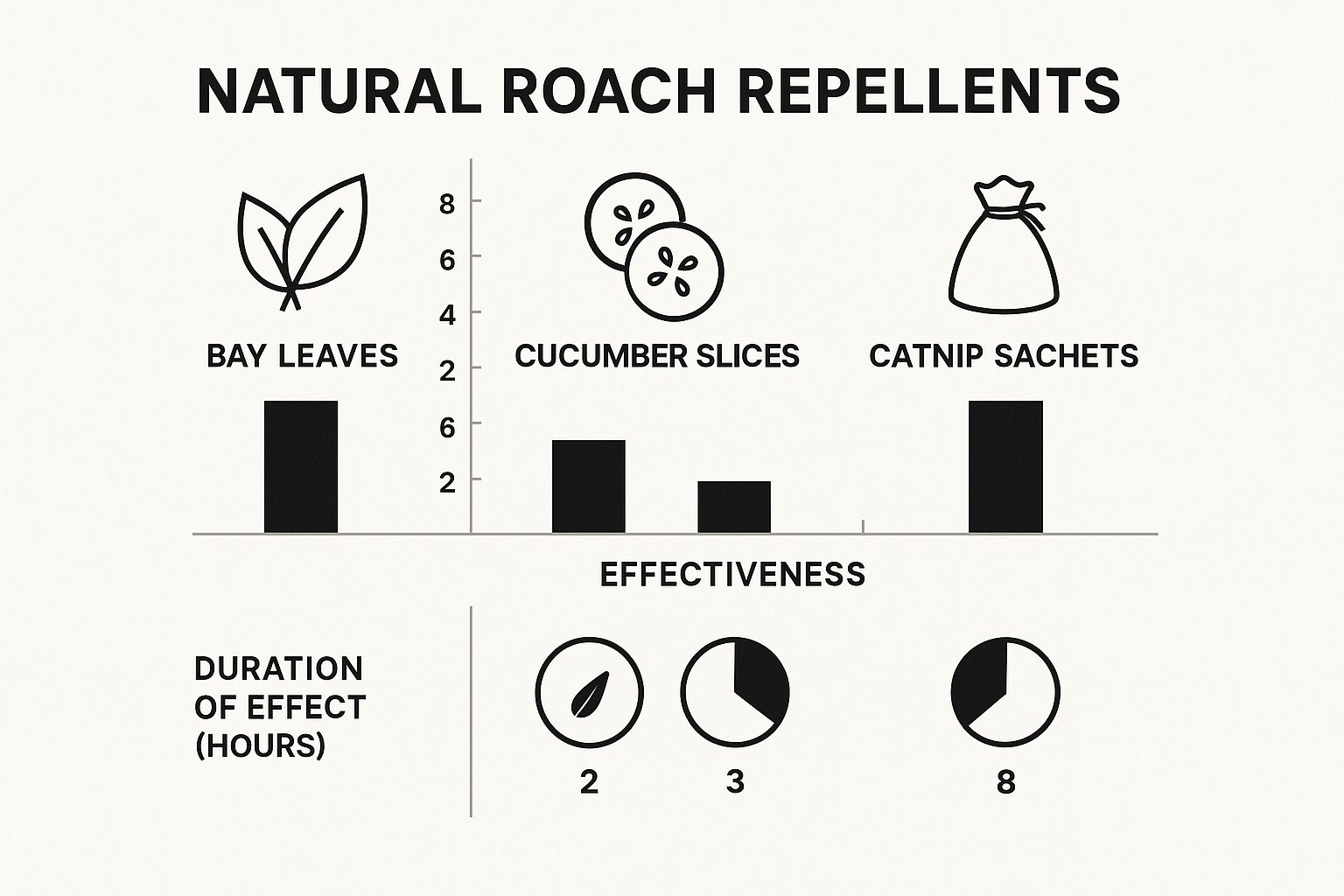
While these options can help a little, their short duration means you have to reapply them constantly just to keep up.
To help you navigate the store aisle, here's a quick breakdown of the most common commercial products and what they're actually good for.
Comparing Common Roach Killer Products
| Product Type | How It Works | Best For | Safety Notes |
|---|---|---|---|
| Gel Baits | Roaches eat the poisoned bait and carry it back to the nest, poisoning the colony. | Eliminating the source of an infestation. Best for kitchens and bathrooms. | Keep out of reach of children and pets. Place in hidden cracks and crevices. |
| Bait Stations | A plastic, child-resistant station containing poisoned bait that roaches enter. | Long-term control in homes with kids or pets, as the poison is enclosed. | Place along walls and in corners where roaches travel. |
| Contact Sprays | Kills roaches immediately on contact with a neurotoxin. | Spot-treating individual roaches seen in the open. | Provides no residual effect. Avoid spraying on food surfaces. Ensure good ventilation. |
| IGRs | Disrupts the roach life cycle, preventing nymphs from becoming breeding adults. | Long-term prevention and breaking the breeding cycle of a large infestation. | Doesn't kill adults, so must be used with a bait or killer product. |
Choosing the right product is about creating a multi-pronged attack plan. However, if you're facing a serious, widespread infestation, it's time to call in the professionals. For an expert evaluation and immediate help, call us at +1 855 224 3071.
Maintaining a Roach-Free Environment Long Term
Getting rid of a current roach problem is a huge relief, but the real win is making sure they never come back. If you feel like you're fighting a never-ending battle, sometimes calling in a pro is the best move. You can reach an expert anytime at +1 855 224 3071 to help you map out a permanent solution.
Think of it this way: eliminating the roaches you see is just step one. True victory comes from building simple, sustainable habits that make your home totally unappealing to these pests for good. It's all about consistency, and it's easier than you'd think.
Building Your Maintenance Routine
Long-term success boils down to a simple, repeatable routine. You don't need to scrub your house from top to bottom every single day. Instead, weaving small, consistent tasks into your weekly and monthly schedule creates a powerful defensive barrier.
This approach methodically cuts off the food, water, and shelter that roaches are always looking for, making sure new pests never even get a chance to move in.
Your Weekly Roach-Proofing Checklist
These quick weekly habits can make a world of difference. They act as preventative maintenance, constantly reinforcing your home’s defenses.
- Hit the High-Traffic Zones: Go beyond a quick sweep. Really get in there and vacuum or mop under the kitchen table, behind your trash cans, and around pet food stations. This is where crumbs and grease love to hide.
- Wipe Down Cabinets and Pantry: Do a quick visual scan of your pantry shelves and kitchen cabinets for any spills or loose food. A simple wipe-down is often all it takes to remove a potential roach buffet.
- Take Trash Seriously: Get all trash, recycling, and compost out of the house regularly. Don't forget to wipe down the inside of the bins themselves to get rid of any sticky, pest-attracting residue.
Your Monthly Deep-Dive Inspection
Set aside a little time once a month to check the spots you normally skip over. This is your best opportunity to spot potential issues before they turn into a full-blown infestation. If the thought of this feels overwhelming, just know that professional backup is always available at +1 855 224 3071.
- Get Behind the Big Appliances: Pull out your stove, refrigerator, and microwave. Roaches are drawn to the warmth and darkness behind them, where they can feast on years of dropped food and grease buildup.
- Scan for New Entry Points: Double-check the cracks and gaps you sealed before. Look for any new cracks that have formed around pipes, in the foundation, or near windows and reseal them with caulk.
- Don't Forget the Yard: Trim back any tree branches or bushes that are touching the side of your house—they're basically a bridge for pests. Also, try to keep any mulch at least 12 inches away from your foundation to prevent creating a damp, roach-friendly zone.
A roach-free home isn't the result of a single intense cleaning session. It's the cumulative effect of small, consistent actions that make your environment fundamentally unwelcoming to pests over the long run.
One last thing to keep in mind is what you bring into your home. Cardboard boxes from deliveries, grocery bags, and especially second-hand furniture are notorious hiding spots for roaches and their egg cases. Always inspect these items outside before you bring them in.
For more expert advice on keeping your home pest-free, check out the helpful articles on our pest control blog. Adopting this long-term mindset is the secret to finally winning the war against roaches.
Common Questions About Keeping Roaches Away
Even with the best game plan, you're bound to have questions. If you need specific advice for what's happening in your home right now, our pest control experts are on standby. Just give us a call at +1 855 224 3071.
In the meantime, let's clear up some of the most common questions and concerns we hear from homeowners battling roaches.
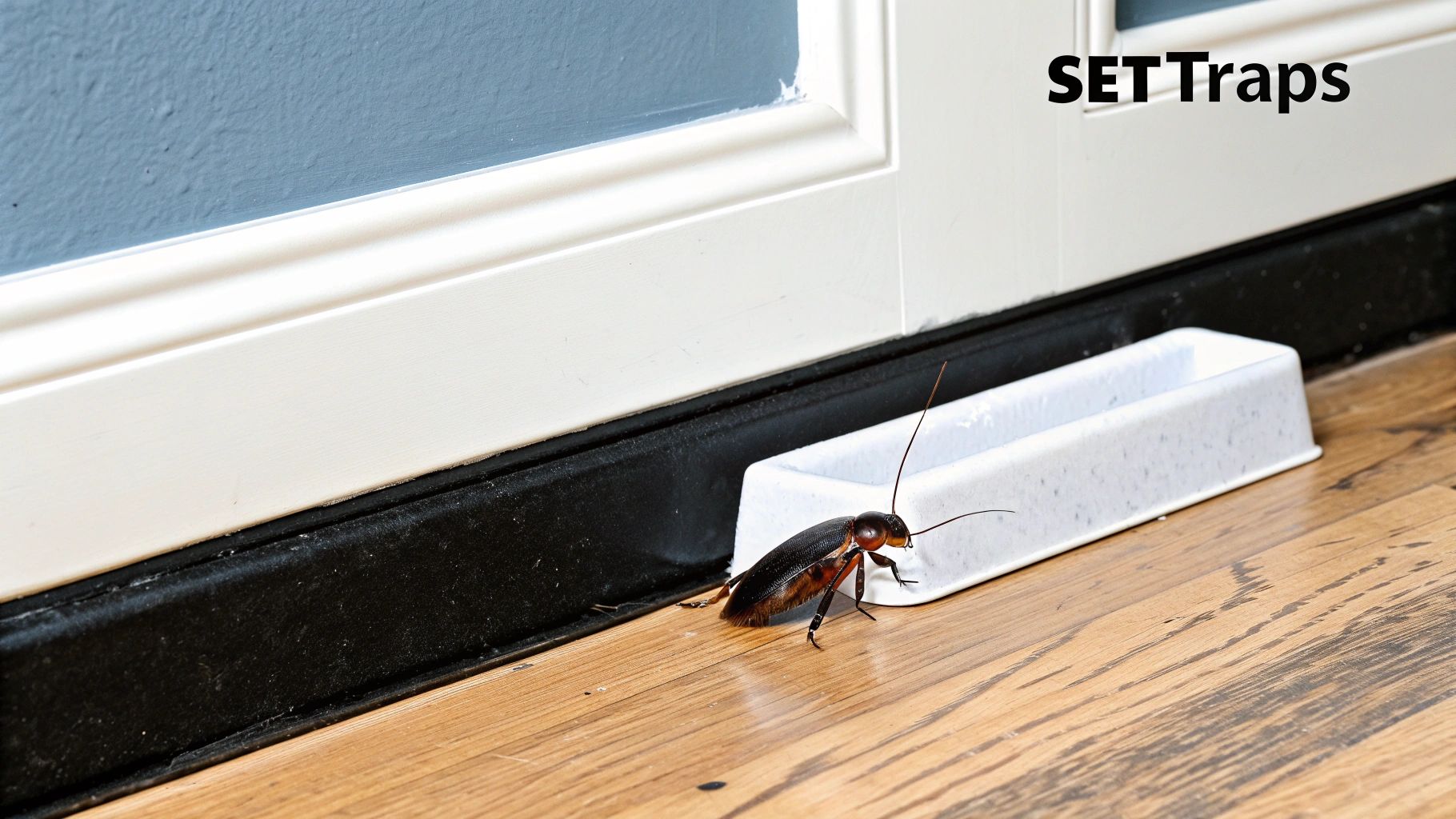
A big one we get is: if I get rid of all the food, won't the roaches just leave? I wish it were that simple. The truth is, it's highly unlikely. Cockroaches are survival machines. They can live for weeks without a single crumb and about a week without water.
Instead of packing their bags, they’ll just widen their search, pushing deeper into wall voids, behind appliances, or into the next room to find anything to eat. That’s why you have to be proactive to get rid of them for good.
I Saw One Roach. Is That a Big Deal?
Spotting a single roach, especially during the day, is a major red flag. Roaches are nocturnal creatures, so if one is bold enough to wander out in the light, it often means their hiding spots are getting too crowded. It's a classic sign of overcrowding.
This is a strong signal that you’ve got a much bigger, hidden population. It’s easy to dismiss one roach, but the safest bet is to assume it’s the tip of the iceberg. After a sighting, your best move is to call for a professional assessment immediately at +1 855 224 3071.
A single roach is rarely just a single roach. It's often the scout for a much larger, unseen colony. Taking immediate action at the first sign is the key to preventing a small problem from escalating into a full-blown infestation.
And this isn't just a local problem; it's a global one. Just look at the pest control market. The Asia Pacific region is expected to dominate the cockroach killer market, with a projected share of over 35% by 2032. This is driven by things like rapid urbanization and dense populations. You can dig into more cockroach killer industry data on dataintelo.com if you're curious.
This worldwide demand just goes to show how stubborn and widespread these pests really are.
Roach Control Myths That Just Won't Die
A few persistent myths can completely sabotage your roach control efforts. The biggest one? That roaches only infest dirty homes. While crumbs and clutter are an open invitation, even spotless homes can get roaches if there's moisture and a way in.
Another huge mistake is thinking a can of bug spray is the answer. A multi-pronged attack is always better.
- Myth: Store-bought sprays will solve the problem.
- Reality: Those sprays only kill the roaches you see. They do absolutely nothing to the nest and can actually make things worse by causing the colony to scatter into new areas of your house.
- Myth: Leaving lights on will keep them away.
- Reality: Sure, roaches prefer the dark, but a lightbulb isn't a force field. A hungry roach will eventually get brave and go searching for food, light or no light.
A real strategy hits them from all sides: sanitation (cleaning), exclusion (sealing entry points), and targeted treatments like baits that they take back to the nest. It's not a one-and-done deal; it's a long-term commitment to making your home a place they want nothing to do with.
Tired of the guessing game? If you want a solution that works, let the experts at Pest Control Service Finder connect you with a vetted, local pro who knows how to handle it.
Don’t wait for one roach to become a hundred. Visit us at https://pestcontrol-service-finder.com to get started.
